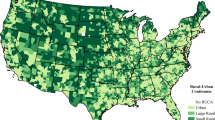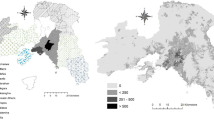Abstract
This paper examines whether sprawl, featured by low development density, segregated land uses, lack of significant centers, and poor street connectivity, contributes to a widening mortality gap between urban and suburban residents. We employ two mortality datasets, including a national cross-sectional dataset examining the impact of metropolitan-level sprawl on urban–suburban mortality gaps and a longitudinal dataset from Portland examining changes in urban–suburban mortality gaps over time. The national and Portland studies provide the only evidence to date that (1) across metropolitan areas, the size of urban–suburban mortality gaps varies by the extent of sprawl: in sprawling metropolitan areas, urban residents have significant excess mortality risks than suburban residents, while in compact metropolitan areas, urbanicity-related excess mortality becomes insignificant; (2) the Portland metropolitan area not only experienced net decreases in mortality rates but also a narrowing urban–suburban mortality gap since its adoption of smart growth regime in the past decade; and (3) the existence of excess mortality among urban residents in US sprawling metropolitan areas, as well as the net mortality decreases and narrowing urban–suburban mortality gap in the Portland metropolitan area, is not attributable to sociodemographic variations. These findings suggest that health threats imposed by sprawl affect urban residents disproportionately compared to suburban residents and that efforts curbing sprawl may mitigate urban–suburban health disparities.





Similar content being viewed by others
Notes
“Smart growth” is antisprawl development that values long-range, holistic considerations of environmental protection, economic growth, and social equity over short-term fiscal considerations. The term of “smart growth” is often used interchangeably with “growth management.” Examples of growth management/smart growth strategies include (a) urban containment boundaries that direct urban development into areas intended or needed for urban uses and protect rural land from urban spillovers, (b) capital improvements programming and adequate facilities standards that discourage developments farther away from existing civil infrastructure systems and encourage infill and redevelopments, (c) land preservation techniques (e.g., transfer of development rights and agriculture/forest buffers) that protect resource land from urban development pressures, etc.
The Generalized Linear Model (GLZ) is an extension of the General Linear Model (GLM) to be used when response variables follow distributions other than the normal distribution and when variances are not constant.
References
Landers J. Mortality and metropolis: the case of London 1675–1825. Popul Stud. 1987; 41: 59–76.
Haines MR. The Urban Mortality Transition in the United States, 1800–1940. NBER Historical Working Papers, National Bureau of Economic Research, Inc; 2001.
Kearns G. The urban penalty and the population history of England. In: Brändström A, Tedebrand L, eds. Society, Health and Population during the Demographic Transition. Stockholm: Almqvist and Wisksell International; 1988: 213–236.
Vlahov D, Galea S, Freudenberg N. The urban health advantage. J Urban Health. 2005; 82: 1–4.
House JS, Lepkowski JM, Williams DR, et al. Excess mortality among urban residents: how much, for whom, and why? Am J Public Health. 2000; 90(12): 1898–1904.
McNeill WH. Migration patterns and infection in traditional societies. In: Stanley N, Joske R, eds. Changing Disease Patterns and Human Behavior. New York: Academic; 1980.
Miller MK, Stokes CS, Clifford WB. A comparison of the rural–urban mortality differential for deaths from all causes, cardiovascular disease and cancer. J Rural Health. 1987; 3(2): 23–34.
Clifford WB, Brannon YS. Rural–urban differentials in mortality. Rural Sociol. 1985; 50(2): 210–224.
Clifford WB, Miller MK, Stokes CS. Rural–urban differences in mortality in the United States, 1970–1980. In: Jahn D, Johnson JW, Wimberley RC, eds. New Dimensions in Rural Policy: Building Upon Our Heritage. Washington: US Government Printing Office; 1986: 63–70.
Kitagawa EM, Hauser PM. Differential Mortality in the United States: A Study in Socioeconomic Epidemiology. Cambridge, MA: Harvard University Press; 1973. vii, 255.
Geronimus AT, Bound J, Waidmann TA. Poverty, time, and place: variation in excess mortality across selected US populations, 1980–1990. J Epidemiol Community Health. 1999; 53(6): 325–334.
Smith MH, Anderson RT, Bradham DD, Longino CF Jr. Rural and urban differences in mortality among Americans 55 years and older: analysis of the national longitudinal mortality study. J Rural Health. 1995; 11(4): 274–285.
Hayward MD, Pienta A, McLaughlin DK. Inequality in men’s mortality: the socioeconomic status gradient and geographic context. J Health Soc Behav. 1997; 38(4): 313–330.
Herbert DT, Thomas CJ. Cities in Space: City as Place. 3rd ed. London: Fulton; 1997.
Schulz A, Northridge ME. Social determinants of health: implications for environmental health promotion. Health Educ Behav. 2004; 31(4): 455–471.
Klitzman S, Matte TD, Kass DE. The urban physical environment and its effects on health. In: Freudenberg N, Galea S, Vlahov D, eds. Cities and the Health of the Public. Nashville, TN: Vanderbilt University Press; 2006. xii, 364.
Frumkin H. Urban sprawl and public health. Public Health Rep. 2002; 117(3): 201–217.
Marshall JD, McKone TE, Deakin E, Nazaroff WW. Inhalation of motor vehicle emissions: effects of urban population and land area. Atmos Environ. 2005; 39(2): 283–295.
Ross CE. Walking, exercising, and smoking: does neighborhood matter? Soc Sci Med. 2000; 51(2): 265–274.
Ewing R, Schmid T, Killingsworth R, Zlot A, Raudenbush S. Relationship between urban sprawl and physical activity, obesity, and morbidity. Am J Health Promot. 2003; 18(1): 47–57.
Frank L, Engelke P. How land use and transportation systems impact public health: a literature review of the relationship between physical activity and built form. In: Centers for Disease Control and Prevention, ed. Active Community Environments (ACE) Working Paper #1; 2000. Available at: http://www.cdc.gov/nccdphp/dnpa/pdf/aces-workingpaper1.pdf.
Ewing R, Schieber RA, Zegeer CV. Urban sprawl as a risk factor in motor vehicle occupant and pedestrian fatalities. Am J Public Health. 2003; 93(9): 1541–1545.
Jargowsky PA, Park Y. Cause or consequence? Suburbanization and crime in US metropolitan areas. Crime Delinq. 2009; 55(1): 28–50.
Godschalk DR. Growing smarter: achieving livable communities, environmental justice, and regional equity. J Environ Plan Manag. 2007; 50(6): 853–854.
Galster G, Hanson R, Ratcliffe MR, Wolman H, Coleman S, Freihage J. Wrestling sprawl to the ground: defining and measuring an elusive concept. Hous Policy Debate. 2001; 12(4): 681–717.
Ewing R, Pendall R, Chen D. Measuring Sprawl and Its Impact. Washington, DC: Smart Growth America; 2002.
King G, Tomz M, Wittenberg J. Making the most of statistical analyses: improving interpretation and presentation. Am J Polit Sci. 2000; 44(2): 341–355.
Song Y, Knaap GJ. Measuring urban form: is Portland winning the war on sprawl? J Am Plan Assoc. 2004; 70(2): 210–225.
Nelson AC. Oregon’s urban growth boundary policy as a landmark planning tool. In: Abbott C, Howe D, Adler S, eds. Planning the Oregon Way: A Twenty-Year Evaluation. Corvallis, OR: Oregon State University Press; 1994: 25–47.
Metro: 2040 regional framework plan and functional plan. Portland, OR; 1996
1000 friends of Oregon: the LUTRAC alternative; 1991. Available at: http://www.friends.org/resources/lut_vol3.ht. Accessed on May 23, 2007.
Nelson AC, Duncan JB. Growth Management Principles and Practices. Chicago, IL: Planners; 1995.
van Hooijdonk C, Droomers M, Deerenberg IM, Mackenbach JP, Kunst AE. Higher mortality in urban neighbourhoods in The Netherlands: who is at risk? J Epidemiol Community Health. 2008; 62(6): 499–505.
Miller MK, Farmer FL, Clarke LL. Rural populations and their health. In: Beaulieu JE, Berry DE, eds. Rural Health Services. Ann Arbor: AUPHA; 1994: 3–26.
Cossman R, Cossman J, Cosby A, Reavis R. Reconsidering the rural–urban continuum in rural health research: a test of stable relationships using mortality as a health measure. Popul Res Policy Rev. 2008; 27: 459–476.
Acknowledgement
The authors thank Professor Gerrit Knaap at the University of Maryland for his gracious assistance in obtaining the Portland mortality data.
Author information
Authors and Affiliations
Corresponding author
Rights and permissions
About this article
Cite this article
Fan, Y., Song, Y. Is Sprawl Associated with a Widening Urban–Suburban Mortality Gap?. J Urban Health 86, 708–728 (2009). https://doi.org/10.1007/s11524-009-9382-3
Received:
Accepted:
Published:
Issue Date:
DOI: https://doi.org/10.1007/s11524-009-9382-3




